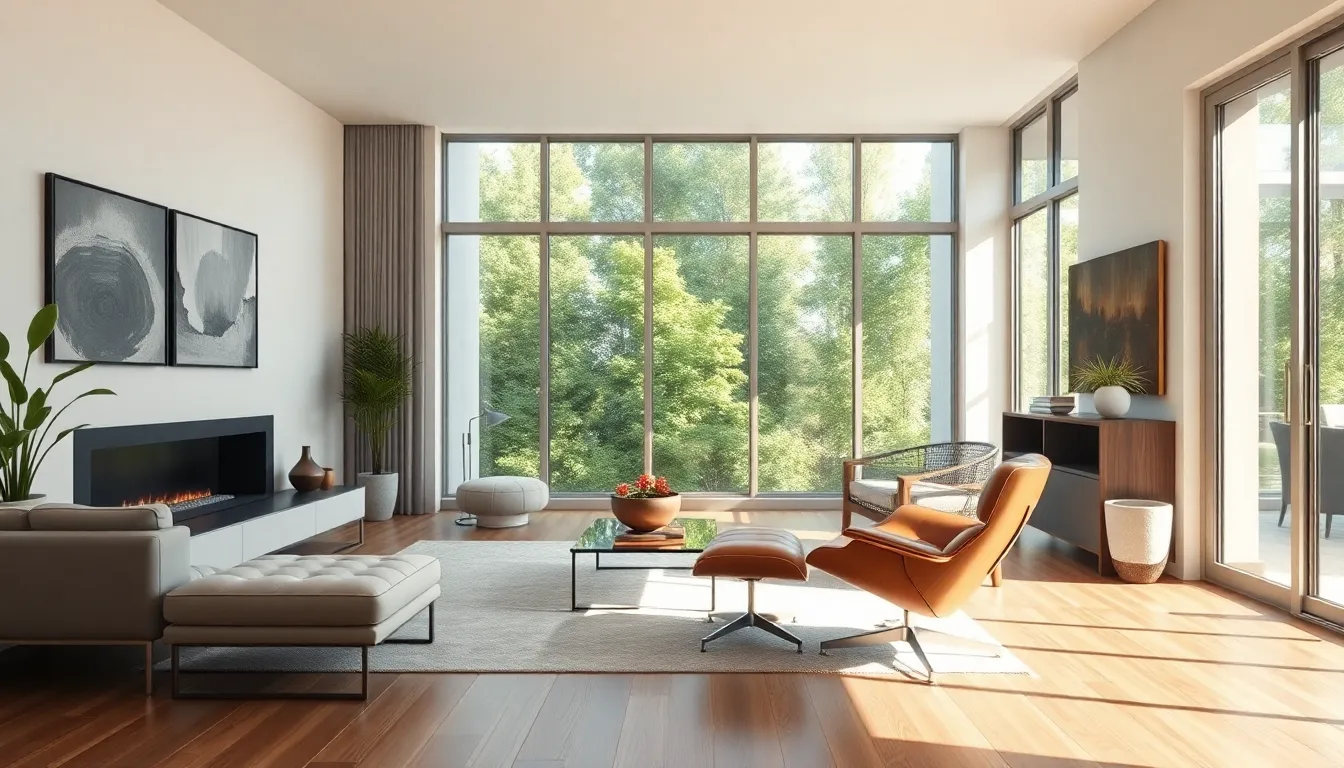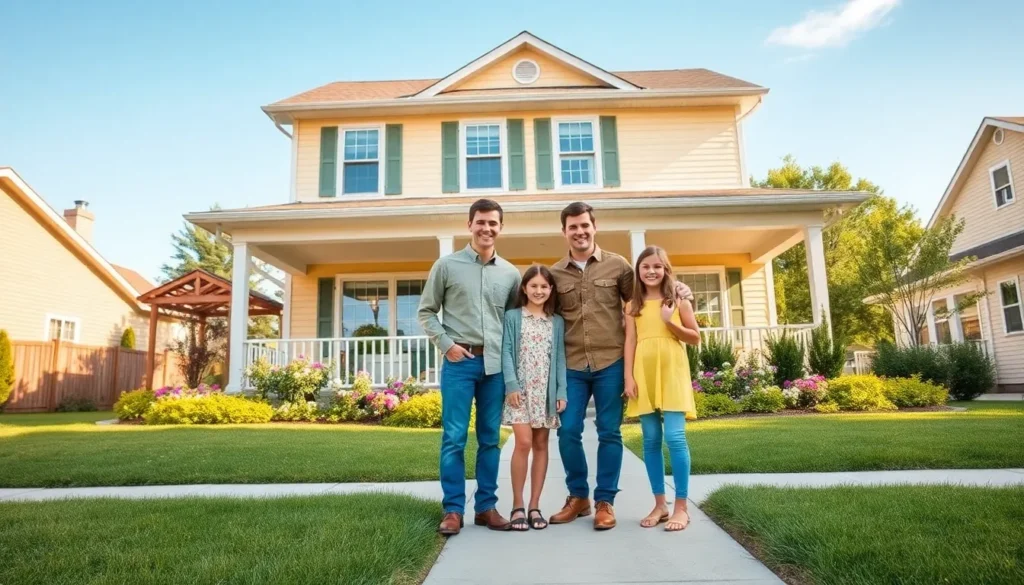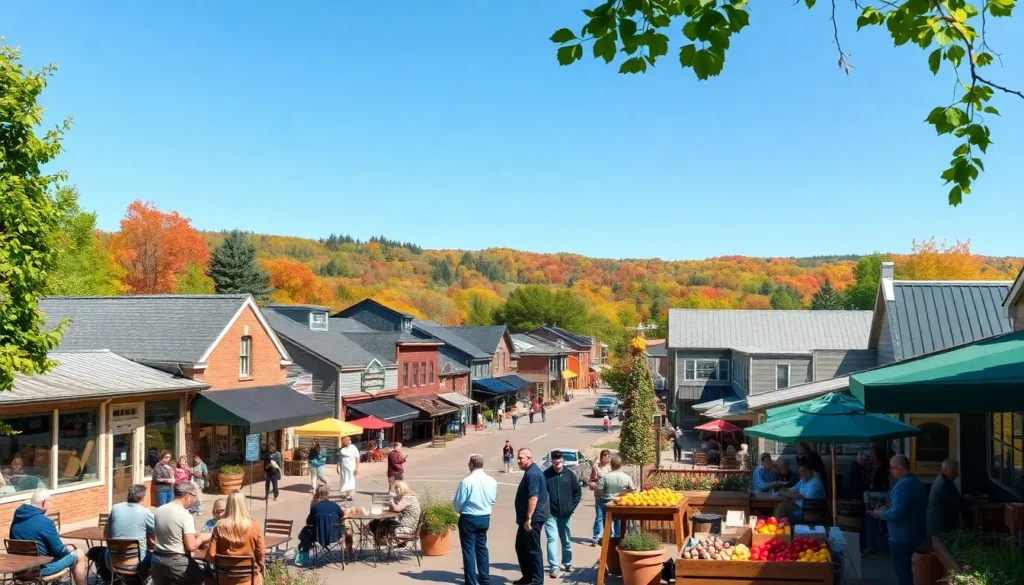Mid-century modern style has captivated design enthusiasts for decades, blending simplicity with elegance. Emerging in the mid-20th century, this aesthetic revolutionized architecture and interior design, characterized by clean lines, organic forms, and a seamless connection to nature. It reflects a time when functionality met artistic expression, creating spaces that are both livable and visually striking.
This design movement emphasizes minimalism and the use of innovative materials, making it a favorite among homeowners and designers alike. From iconic furniture pieces to striking architectural designs, mid-century modern style continues to influence contemporary aesthetics, proving that its charm remains timeless. Exploring its key elements reveals a rich history and a lasting impact on the way we experience our living environments.
Table of Contents
ToggleOverview of Mid-Century Modern Style
Mid-century modern style originated in the United States during the 1940s and continued into the 1960s. It represents a significant movement in design, driven by the desire for functionality and clarity. This aesthetic emphasizes clean lines and minimal ornamentation, creating a sense of openness and simplicity.
Key characteristics include:
- Organic Forms: Designers like Eero Saarinen favored smooth, flowing shapes that mirrored nature’s forms.
- Innovative Materials: This style utilized new materials such as plywood, fiberglass, and aluminum, allowing for versatile and creative applications.
- Integration with Nature: Large windows and open floor plans established a seamless connection between indoor and outdoor spaces, showcasing the natural environment.
Mid-century modern architecture often features flat planes, large glass windows, and cantilevered roofs. Interiors reflect a harmonious balance between functionality and style, focusing on creating inviting living spaces. The aesthetic encourages the use of vibrant colors in accessories, while furniture often showcases geometric patterns and tapered legs.
Notable designers, including Charles and Ray Eames, contributed to the style’s legacy through iconic furniture pieces that remain popular today. This enduring appeal of mid-century modern style continues to influence contemporary design, blending nostalgia with modern sensibilities.
Key Characteristics of Mid-Century Modern Style

Mid-century modern style showcases distinctive elements that define its unique aesthetic. These characteristics create a cohesive look that blends artistry with practical design.
Clean Lines and Organic Forms
Clean lines and organic forms characterize mid-century modern design. Designers prioritize simplicity, resulting in shapes that emphasize functionality without unnecessary embellishments. Organic forms mirror natural elements, promoting harmony between indoor and outdoor environments. This focus leads to furniture and architecture that appear effortlessly integrated into their surroundings. Examples include the iconic Eames Lounge Chair, which combines sleek lines with a comfortable, sculptural design.
Functionality and Minimalism
Functionality and minimalism are core principles of mid-century modern style. Designers create spaces that maximize usability while eliminating clutter. Each piece serves a purpose, ensuring that aesthetics do not compromise practicality. Open floor plans and multifunctional furniture illustrate this philosophy, as they foster a sense of flow and spaciousness. Notable examples include modular shelving units, which adapt to various needs while maintaining a clean, uncluttered appearance.
Influential Designers of the Era
Mid-century modern style owes much of its popularity to influential designers who shaped the movement. Their innovative designs and functional aesthetics persist in contemporary interiors.
Charles and Ray Eames
Charles and Ray Eames significantly transformed furniture design during the mid-century period. Their contributions include the iconic Eames Lounge Chair, which features molded plywood and luxurious leather, exemplifying both comfort and style. The couple prioritized functionality, creating pieces like the Eames Wire Chair that embrace simplicity while maintaining aesthetic appeal. Their designs remain prevalent in modern homes and public spaces, proving their lasting impact on the design landscape.
Eero Saarinen
Eero Saarinen redefined architectural forms and spaces through his vision. Renowned for the TWA Flight Center and the Gateway Arch, Saarinen emphasized organic shapes and fluid lines. His Tulip Chair, crafted from a single pedestal base, highlights his commitment to innovative materials and modern aesthetics. Saarinen’s work reflects a harmonious blend of form and function, leaving a significant mark on mid-century modern architecture and furniture design.
Popular Mid-Century Modern Furniture
Mid-century modern furniture features distinctive designs that emphasize functionality, aesthetics, and innovative use of materials. The following sections highlight iconic pieces and the material choices that define this enduring style.
Iconic Pieces
- Eames Lounge Chair: The Eames Lounge Chair, designed by Charles and Ray Eames in 1956, embodies comfort and sophistication with its molded plywood and leather upholstery. This piece remains a hallmark of mid-century modern design.
- Tulip Table: Eero Saarinen’s Tulip Table, introduced in 1956, features a single pedestal base that eliminates clutter and promotes visual flow. The smooth lines and minimalistic design capture the essence of mid-century modern aesthetics.
- Wishbone Chair: Hans J. Wegner’s Wishbone Chair, created in 1949, showcases elegant simplicity with its curved backrest and natural materials. This chair represents a seamless blend of form and function, popular in contemporary settings.
- Mogens Lassen Candlesticks: Designed by Mogens Lassen in the 1960s, these brass candlesticks feature geometric forms that highlight mid-century modern design principles. Their timeless aesthetic enhances various interior styles.
- Noguchi Coffee Table: Isamu Noguchi’s Coffee Table, designed in 1948, combines a clear glass top with an organic wooden base. This table exemplifies the movement’s emphasis on harmonious shapes and practicality.
Material Choices
- Plywood: Plywood plays a crucial role in mid-century modern furniture, offering both strength and flexibility. Designers utilize its laminated layers to create ergonomic shapes while maintaining durability.
- Fiberglass: Fiberglass became a popular material due to its lightweight properties and versatility. Chairs and tables crafted from fiberglass showcase vibrant colors and complex forms, contributing to standout designs.
- Aluminum: Aluminum’s lightweight nature and resistance to corrosion make it an ideal choice for outdoor and indoor furniture. Its sleek finish aligns with the movement’s focus on modernity and innovation.
- Leather: Leather upholstery adds comfort and sophistication to mid-century modern furniture. Designers often select high-quality, natural leather to enhance the overall aesthetic while ensuring longevity.
- Wood: Wood remains a staple for mid-century modern furniture, typically featuring walnut, teak, or oak finishes. These woods provide warmth and richness, balancing the movement’s minimalist aspects.
Mid-Century Modern Style in Contemporary Design
Mid-century modern style remains a vital influence in contemporary design, characterized by its clean lines and functional forms. Designers often incorporate elements from this style to create harmonious spaces that emphasize both aesthetics and practicality.
Key Features in Modern Spaces
- Open Floor Plans: Open layouts promote flow, reflecting the mid-century philosophy of integration between living areas and the outdoors. This concept enhances natural light and spatial awareness, common in modern homes.
- Multifunctional Furniture: Furniture designs often prioritize versatility, echoing the mid-century approach of maximizing utility. Pieces like convertible sofas or nesting tables exemplify this trend.
- Natural Materials: Contemporary designers utilize plywood, fiberglass, and wood to echo mid-century modern materials. These choices not only enhance durability but also maintain the style’s foundational connection to nature.
Revived Color Palettes
- Earthy Tones: Modern design frequently adopts earthy colors reminiscent of mid-century palettes. Shades of olive green, mustard yellow, and terracotta create warm and inviting atmospheres in contemporary interiors.
- Bold Accents: Designers integrate bright accents, including orange and turquoise, using these colors to highlight focal points while paying homage to mid-century vibrancy.
Iconic Furniture Reimagined
- Eames Lounge Chair: This timeless piece continues to influence modern seating options, often reinterpreted in new materials and colors to suit contemporary aesthetics.
- Tulip Table: Its sleek form inspires a variety of modern dining arrangements, marrying functionality with a distinctive sculptural quality.
Influence on Architecture
- Large Windows: Integrated design that features expansive glass elements allows natural light to permeate spaces, reflecting the mid-century focus on bridging indoor and outdoor environments.
- Organic Shapes: Influenced by architects like Eero Saarinen, modern buildings often embrace flowing forms, promoting an aesthetic that resonates with both nature and structure.
Sustainability and Mid-Century Values
Emphasis on sustainability aligns closely with mid-century modern principles, valuing quality materials and craftsmanship. Contemporary designers focus on creating long-lasting pieces that minimize waste, reflecting the era’s innovation and thoughtfulness.
Mid-century modern style’s principles continue to shape contemporary design, contributing to a balanced aesthetic that remains as relevant today as it did in its inception. The blend of functionality, beauty, and environmental awareness exemplifies its enduring legacy in modern interiors and architecture.
Mid-century modern style embodies a timeless elegance that resonates with both past and present. Its focus on clean lines and organic forms continues to inspire designers and homeowners alike. By seamlessly blending functionality with aesthetic appeal, this design movement remains relevant in contemporary spaces.
As modern designers draw from mid-century principles, they create environments that prioritize sustainability and craftsmanship. The legacy of iconic pieces and innovative materials ensures that mid-century modern style will endure for generations to come. Embracing this style not only enhances interior aesthetics but also fosters a deeper connection to nature and functionality.



